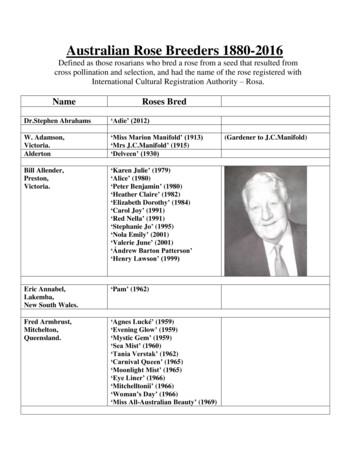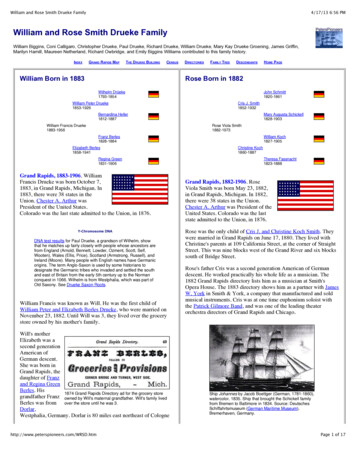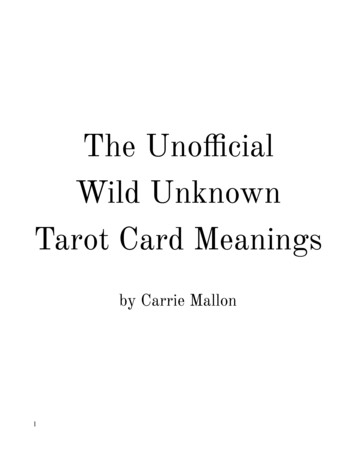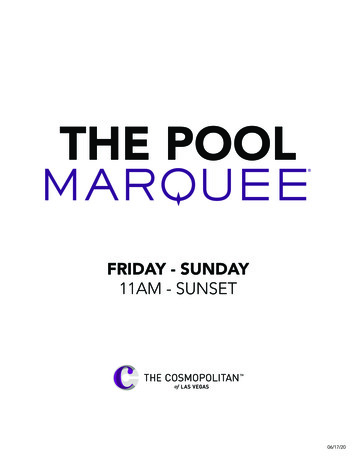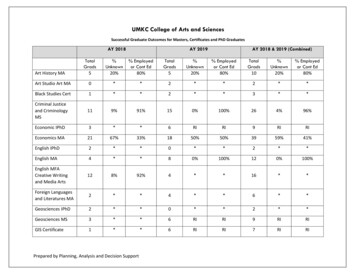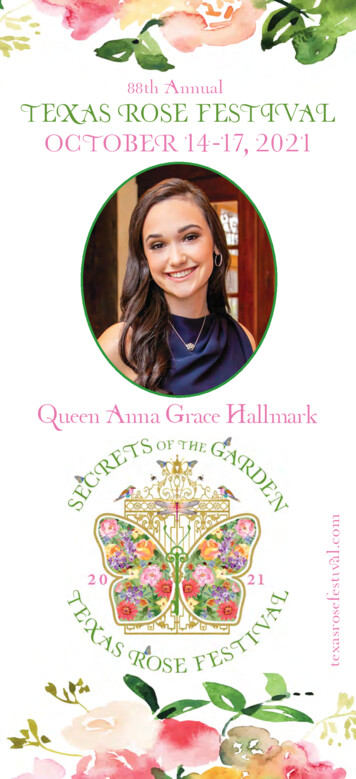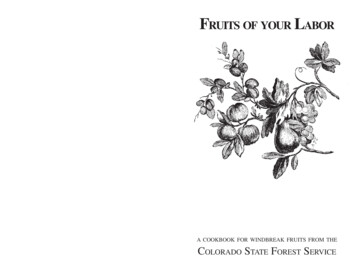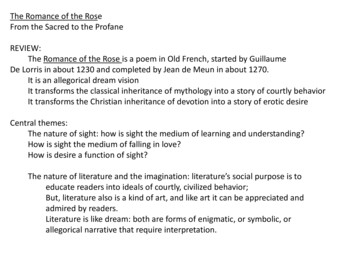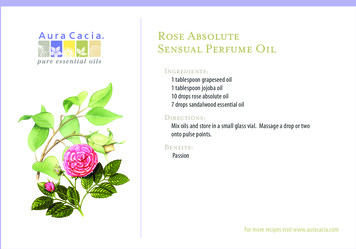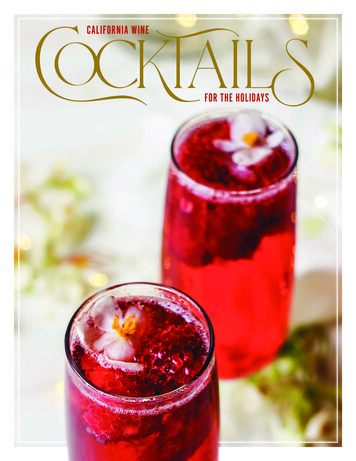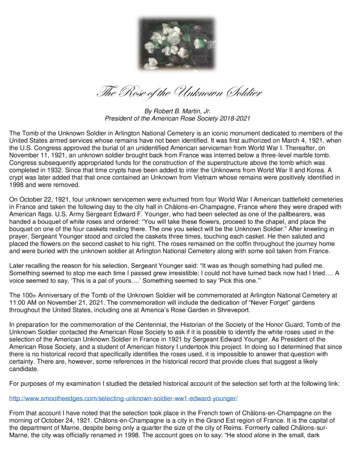
Transcription
The Rose of the Unknown SoldierBy Robert B. Martin, Jr.President of the American Rose Society 2018-2021The Tomb of the Unknown Soldier in Arlington National Cemetery is an iconic monument dedicated to members of theUnited States armed services whose remains have not been identified. It was first authorized on March 4, 1921, whenthe U.S. Congress approved the burial of an unidentified American serviceman from World War I. Thereafter, onNovember 11, 1921, an unknown soldier brought back from France was interred below a three-level marble tomb.Congress subsequently appropriated funds for the construction of the superstructure above the tomb which wascompleted in 1932. Since that time crypts have been added to inter the Unknowns from World War II and Korea. Acrypt was later added that that once contained an Unknown from Vietnam whose remains were positively identified in1998 and were removed.On October 22, 1921, four unknown servicemen were exhumed from four World War I American battlefield cemeteriesin France and taken the following day to the city hall in Châlons-en-Champagne, France where they were draped withAmerican flags. U.S. Army Sergeant Edward F. Younger, who had been selected as one of the pallbearers, washanded a bouquet of white roses and ordered: “You will take these flowers, proceed to the chapel, and place thebouquet on one of the four caskets resting there. The one you select will be the Unknown Soldier.” After kneeling inprayer, Sergeant Younger stood and circled the caskets three times, touching each casket. He then saluted andplaced the flowers on the second casket to his right. The roses remained on the coffin throughout the journey homeand were buried with the unknown soldier at Arlington National Cemetery along with some soil taken from France.Later recalling the reason for his selection, Sergeant Younger said: “It was as though something had pulled me.Something seemed to stop me each time I passed grew irresistible; I could not have turned back now had I tried . Avoice seemed to say, ‘This is a pal of yours .’ Something seemed to say ‘Pick this one.’”The 100th Anniversary of the Tomb of the Unknown Soldier will be commemorated at Arlington National Cemetery at11:00 AM on November 21, 2021. The commemoration will include the dedication of “Never Forget” gardensthroughout the United States, including one at America’s Rose Garden in Shreveport.In preparation for the commemoration of the Centennial, the Historian of the Society of the Honor Guard, Tomb of theUnknown Soldier contacted the American Rose Society to ask if it is possible to identify the white roses used in theselection of the American Unknown Soldier in France in 1921 by Sergeant Edward Younger. As President of theAmerican Rose Society, and a student of American history I undertook this project. In doing so I determined that sincethere is no historical record that specifically identifies the roses used, it is impossible to answer that question withcertainty. There are, however, some references in the historical record that provide clues that suggest a likelycandidate.For purposes of my examination I studied the detailed historical account of the selection set forth at the following -soldier-ww1-edward-younger/From that account I have noted that the selection took place in the French town of Châlons-en-Champagne on themorning of October 24, 1921. Châlons-en-Champagne is a city in the Grand Est region of France. It is the capital ofthe department of Marne, despite being only a quarter the size of the city of Reims. Formerly called Châlons-surMarne, the city was officially renamed in 1998. The account goes on to say: “He stood alone in the small, dark
octagonal room holding the bouquet of white roses cut from the garden of French parents who had lost two sons to thewar.”From the above, the record tells us that the roses were cut from a French garden, perhaps locally, prior to October 24,1921. That tells me the rose must have been introduced in commerce, most likely in France, some time prior to 1921.The time of year also indicates than the rose was a repeat-flowering variety that would have been blooming in the fall,as opposed to a once-flowering rose that blooms only in the spring.A photo of Sergeant Younger “re-creating’ his selection on May 30, 1930 has a close up of white roses of distinctivetea form, also popular among florist roses at the time. That however is a “re-creation” that took place nine years later inWashington DC so it is unlikely that the same variety of rose was used in the re-creation. The type of rose, however, islikely to have been the same. The indistinct photos of the actual bouquet on the casket in 1921 also suggest that therose was a tea rose. Tea roses are also typically repeat blooming, which suggests that they could have been in bloomin France in late October 1921, however because of the time of year, it is most likely the roses were blooming in agreenhouse. Tea-formed roses were then, and indeed now are, the primary type of rose used by florists andrecognized by the public as “roses”. They also typically come with long stems which admit to arrangement in a bouquetsuch as the one used in the selection.Taking this information, I studied likely candidates of white tea roses popular in France circa 1921. I did this through anadvanced search of the website HelpMeFind. That turned up several candidates, the most likely of which is ‘Niphetos’a white tea rose hybridized by the French breeder Bougere in 1841.‘Niphetos’ is variously translated from the Greek as “snowing” or “falling snow”. The rose is also sometimes referred toas “The Wedding Rose” or “The Bridal Rose” because of its use at weddings. Contemporaneous accounts described itas: “Large, full, tulip-like form, pure white, buds long a delightful rose.” Others said, “No white Tea can beat it forpurity in color.” The French Journal des Roses summed up the description thus: “Represents among roses, a perfectdistinction, a supreme elegance, finesse and finally nobility.”Because of these characteristics ‘Niphetos’ was a popular florist rose following its introduction and would likely haveremained so after the War in 1921. It was not, however, considered a good garden rose because of its susceptibility torain and because it opened poorly. Its quality as a bud, however, marked itaccording to then contemporary sources as “in essence a greenhouse rose.”The fact that the selection roses were cut in late October in France increases the likelihood that the roses were from agreenhouse instead of a local garden at the end of the French rose growing season. In addition, it is fair to assumethat the destruction in France during the Great War would have made it unlikely that there were many local gardens inOctober 1921 that could supply a bouquet of white roses.This leads to an intriguing reference that may be just coincidence but perhaps not. There is an article in the 1922American Rose Annual, at p. 132, titled “Among European Rosarians”, by E. A. White, Professor of Floriculture,Cornell University. The Editors Note by J. Horace McFarland, the Father of the American Rose Society providesfurther detail on Professor White:“Editor’s Note: To get rose observations at first hand by a competent rosarian is very much worthwhile. ProfessorWhite, who was the efficient secretary of the American Rose Society for several years, and until his increasing dutiesmade continuance impracticable, has provided us with just such observations.”Professor White’s trip include one to France where he visited prominent gardens and nurseries in the fall of 1921,coincidentally at the same time of the selection of the American Unknown Solider. Among those gardens were thenurseries of Joseph Pernet-Ducher.Joseph Pernet-Ducher (1859–1928) was a French rosarian and hybridizer. Born near Lyon, the son of Jean Pernet, hewas a third generation rose-grower. In 1879 he began his apprenticeship in the rose-breeding business with theDucher nursery in Lyon. In 1882, he married Marie Ducher, the owner’s daughter, and adopted the name “PernetDucher” to signify the two rose growing entities.Using Rosa foetida in 1887, he and his father began developing yellow rose cultivars through a cross between a redhybrid perpetual and ‘Persian Yellow’. After his father’s death in 1896, Joseph Pernet-Ducher carried on theexperiments and developed a worldwide reputation in 1900 when he introduced ‘Soleil d’Or’, the first yellow Hybrid
Tea. This rose it is now recognized as the first of the “Pernetiana” roses (Roses of Pernet) and an important ancestorof the legendary rose ‘Peace’, introduced in 1945 following World War II.Between 1907 and 1925, Joseph Pernet-Ducher won the Gold Medal thirteen times at the “Concours de Bagatelle”,the international competition for new roses held each June in Paris.Recalling his trip in 1921, Professor White went on to say:“On my arrival at Lyons, I found a note from M. Pernet-Ducher saying his daughter would call for me early Thursday totake me to their nurseries. Mlle. Pernet speaks excellent English and acted both as guide and interpreter for me duringthe entire day. The war brought deep sadness to their home in that it took both sons, Claudius, 31 years old, andGeorges, aged 28 years. The morning was spent among the roses.”Recalling the detail of the origin of the roses used in the selection, we are told they came from “the garden of Frenchparents who had lost two sons to the war”, I compared that to the note of Professor White that “The war brought deepsadness to their home in that it took both sons, Claudius, 31 years old, and Georges, aged 28 years.” In fact, JosephPernet-Ducher’s named the roses ‘Souvenir de Claudius Pernet’ and the ‘Souvenir de Georges Pernet’ in theirmemory.I looked at the Google Map and note that Lyons is some distance to the Southeast of the town of Châlons-enChampagne, albeit on the rail lines. The nurseries of Joseph Pernet-Ducher in Lyons were not therefore local. On theother hand, we do know that Joseph Pernet-Ducher was a prominent rosarian and nurseryman in France whosegarden and greenhouse were full of roses in the fall of 1921, including no doubt the popular white Tea rose, ‘Niphetos”.The account of the selection of the American Unknown Solider has a number of “coincidences” and perhaps the visit ofProfessor White to the nurseries of Joseph Pernet-Ducher in 1921 is just that. Then again, how many greenhousesexisted in war-torn France on October 24, 1921 owned by a man of roses who lost two sons in the War? I suspectthere was but one, which fact would explain the voice in my head that seems to say: “the roses used in the selection ofthe American Unknown Soldier in France in 1921 by Sergeant Edward Younger were a bouquet of the pure white Tearose ‘Niphetos” from the gardens of Joseph Pernet-Ducher, the famous French nurseryman near Lyons who hadhimself lost two sons in the Great War.”‘Niphetos’ continues to be available from three US and six foreign sources to this day.Photos: In 1930, Sgt Younger recreates his selection of the second casket as the one on which to lay the white rosebouquet; Sgt Edward Younger; Bouquet of ‘Niphetos’ – thought to be the rose used in the bouquet for the casket of theUnknown Soldier; The Unknown Soldier selected. 1921; ‘Niphetos’ rose painting on a cigarette card; Burial of theUnknown Soldier at his Tomb at Arlington National Cemetery; “Toward Havre,” flag-draped casket with ‘Niphetos’ rosebouquet; Rose Man Joseph Pernet-Ducher; “White Niphetos roses by Williams Anderson on Artnet;” The Tomb.
octagonal room holding the bouquet of white roses cut from the garden of French parents who had lost two sons to the war." From the above, the record tells us that the roses were cut from a French garden, perhaps locally, prior to October 24, . The war brought deep sadness to their home in that it took both sons, Claudius, 31 years old, and .
